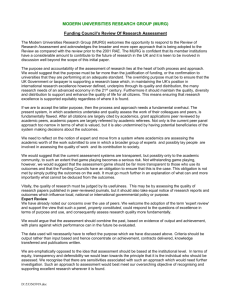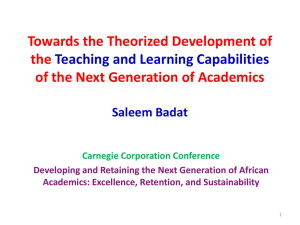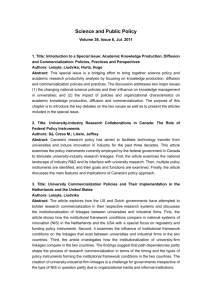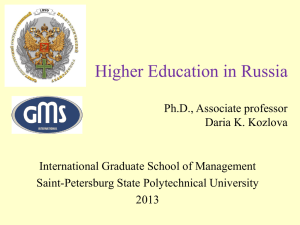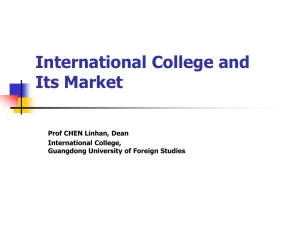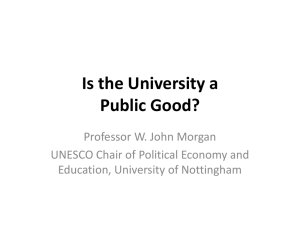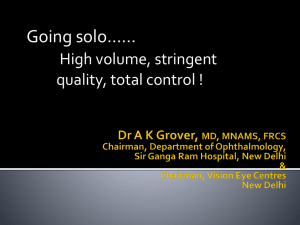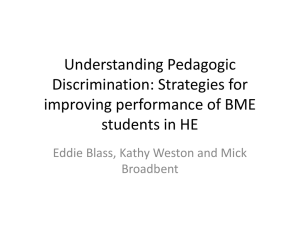Title of slide show - The Policy Action > Network
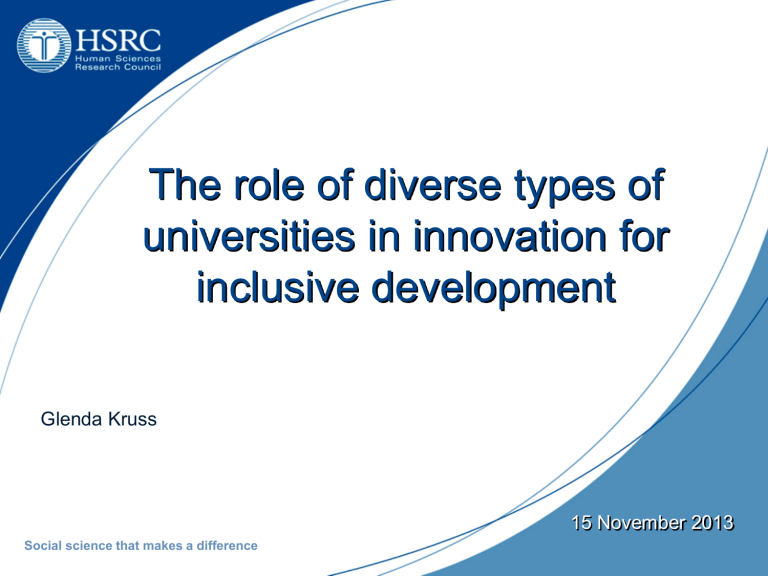
Glenda Kruss
The role of diverse types of universities in innovation for inclusive development
15 November 2013
Social science that makes a difference
Universities and innovation for inclusive development
• Inclusive development : process of increasing livelihoods and capacities among people who are currently marginalised
(Cozzens and Sutz 2012)
• ‘’reduces poverty, enables all groups to create opportunities, share the benefits of development and participate in decisionmaking “ (UNESCO )
• Foregrounds a gency and participatory processes of marginalised communities
• Innovation : a new product, or process, or form of organisation for production; ‘new to the world’, or ‘country’, ‘firm’, ‘community’, adapting to local settings; STI led or DUI mode, codified or tacit knowledge; learning and diffusion processes amongst adopter or users
• Universities : disciplinary reputations and traditions, change driven by substantive nature as generators of new knowledge – in context of multiple new roles and expectations from government and market – how respond?
Firms
Higher education system in SA NSI
Research universities, universities of technology, comprehensive universities, rural universities:
• diverse histories, missions and expertise
• differing balance of multiple teaching, research, innovation and outreach activities and priorities
• “Extending scholarship to direct benefit of range of external social partners consistent with departmental / institutional / regional / national missions ”
Government
Marginalised communities
Civil society
Academics
No Engagement
On isolated scale
Moderate scale with a single partner
Moderate scale with two or more partners
Number of academics in sample
Number of academics in institution
Awareness, in that 81% engage BUT scale of active interaction low, and few networks
Research university 1
Research university 2
Comprehen
-sive university
Rural university
University of
Technology
24% 7% 21% 14% 26%
34% 38% 38% 40% 17%
28%
14%
738
1 186
33%
23%
442
716
23%
18%
343
563
24%
22%
274
290
21%
37%
462
722
Community service teaching oriented pattern (Research 1)
Firm and user-oriented research pattern (UoT )
•
• International recognition and academic • Technology and workplace learning reputation local relevance and (WIL/Service) focus<=> a new identity compliance with national engagement policy imperatives
Traditional academic activities: ¼ no
• and academic reputation
Traditional academic teaching activities: ¼ no engagement engagement; 1/3 frequent but single academic partner
• 14% interacted frequently, with health, firm, government and welfare partners: ‘Customised service’ and
‘community service’ teaching types of
• 37% frequent interaction, with multiple partners (firm and government; community development): education of responsive students and workintegrated learning most frequent but community-based research, customised training and firm-oriented relationships; academic channels, least direct and formalised, and customised expert channels, most relationships important; tacit, technology transfer or user oriented frequent; to benefit of academics, but a very small set of community service teaching relationships with wider social benefits channels of interaction; to benefit of academics and firms, communities
Patterns of interaction across system
1.
General awareness and commitment to ‘’engagement’’
2.
BUT large proportion interpret that to mean interaction with a single academic partner
3.
Interaction tends to be oriented to teaching and student learning, or to outreach and service missions (philanthropic and charity), unrelated to core academic roles and scholarship
4.
Partners tend to be academics -> communities -> firms
5.
Very little oriented to research, or to innovation and technology transfer (and these tend to involve firm partners not marginalised communities)
6.
Very few relationships or channels evidence of IID – mostly uni-directional knowledge flows, indirect traditional forms
6.
Outcomes primarily to academic benefit, or community and social development, very little oriented to productivity and employment generation
7.
Pattern in each university is complex and messy, differs in line with strategic challenges of distinct types, intersecting with historical trajectories and cultures
8.
Misalignment of national higher education and innovation agendas reflected within fragmentation of organisational structures to promote engagement, research and innovation
9.
Absence of networks – weak state of collaboration and knowledge flows across organisations in the higher education system and across NSI
Very little interaction between knowledge producers and marginalised communities
Social science that makes a difference
Implications for interaction to promote innovation for inclusive development
1.
Conceptualise and promote a new approach of innovation for inclusive development across NSI
2.
An understanding of local demand and the specificities of innovation and interactive dynamics in marginalised communities is a prerequisite
3.
Identify ways to promote bi-directional and direct forms of interaction to mutual benefit of university and marginalised communities
4.
Develop interactive capabilities of academics, heads of departments, institutional managers and leaders
5.
Promote coordination and alignment between universities,
PRIs and other development / intermediary agencies in


